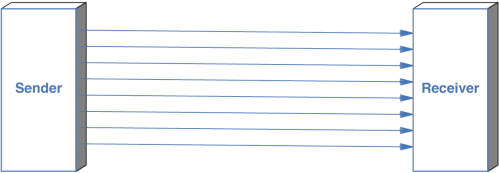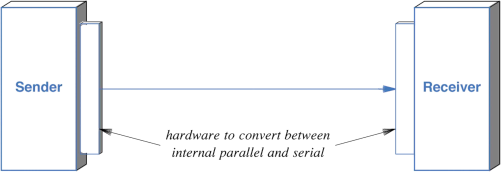- Number of Lines.
- Parallel transmission: Multiple, independent connections.
- Multiple connections in use simultaneously.
- Several bits sent simultaneously, one per line.
- Usually a few extra lines for timing control.
- High throughput.

- Frequently used inside computers; matches the hardware.
- Serial transmission: Bits sent on one line, one after another.
- Specialized hardware.
- Converts between a parallel hardware signal and serial line.
- Sender receives bits in parallel on one side, doles them out serially on the other. Receiver the reverse.
- UART or USART, depending on the timing of the serial connection.
- Transmission order.
A collection of bits sent serially must be sent in some order.
- Endpoints must agree on order.
- Usually sent in ascending or descending place value.
- Least-significant first: little-endian.
- Most-significant first: big-endian.
- Order of bytes within words may be specified differently than bits within bytes.
- Ethernet sends bytes big-endian, and bits little-endian.
- 32-bit number:
b31b30b29b28b27b26b25b24 b23b22b21b20b19b18b17b16 b15b14b13b12b11b10b9b8 b7b6b5b4b3b2b1b0
- Bytes little-endian; bits in bytes, big-endian:
b7b6b5b4b3b2b1b0 b15b14b13b12b11b10b9b8 b23b22b21b20b19b18b17b16 b31b30b29b28b27b26b25b24
- Bytes big-endian; bits in bytes, little-endian (Ethernet):
b24b25b26b27b28b29b30b31 b16b17b18b19b20b21b22b23 b8b9b10b11b12b13b14b15 b0b1b2b3b4b5b6b7
- Both little:
b0b1b2b3b4b5b6b7 b8b9b10b11b12b13b14b15 b16b17b18b19b20b21b22b23 b24b25b26b27b28b29b30b31
- 32-bit number:
- Timing
- Asynchronous.
- The medium may be idle for an arbitrary time between transmissions.
- Each transmission must be synchronized.
- RS-232 is a common serial standard.

- Extra bits warn the receiver to start recording bits, and mark the end of the byte.
- Synchronous.
- The medium is always transmitting, and stays synchronized.
- Transmission divided into blocks, called frames.
- Marked by some starting and ending pattern.
- Marks usually designed to have a level change which can be used to keep the receiver's clock in sync.
- There is an idle frame which, indicates the contents is to be discarded. Used when sender has nothing to say.
- Isochronous.
- Type of synchronous transport designed to accept and deliver data at a fixed rate.
- Avoids any jitter in a multimedia recording.
- Traditional in phone networks.
- Asynchronous.

- Specialized hardware.

- Parallel transmission: Multiple, independent connections.
- Plex
- Simplex. Transmission in one direction (broadcast TV).
- Duplex. Simultaneous transmission in both directions (telephone).
- Half-Duplex. Transmission in both directions, but only one at a time. (Walkie-talkie).
- DCE and DTE
- Old phone company terms.
- DCE Data Communications Equipment.
- DTE Data Terminal equipment.
- The DCE is the start of the phone company network.
- The DTE is the last part of the subscriber network.
- They are connected, carrying data from one to the other. Interface between the subscriber and phone company.
- The importance notion is that a standard interface can be defined between two different networking technologies.
- Old phone company terms.